As the web is evolving many are becoming familiar with how content and keyword research into audience and user habits can benefit businesses. Further planning and investigation can help drive traffic and revenue. This, in turn, is also likely to generate return visits, socials shares, user-generated content along with other benefits.
Bridging the keyword gap
Initial research is vital, and what better research to conduct than competitor analysis. Evaluating what your competitors are doing can help you discover missed opportunities that they may have grasped.
It could be that your competitors have already done all the hard work in the initial research stage, which is there for you to take advantage of by using a few methods, strategies and tools.
What is keyword gap analysis?
Keyword gap analysis is discovering the gap between your competitor's domains or pages with ranking keywords. Most SEO tools will evaluate and identify which keywords you might be missing that some, or all, of your competitors are ranking for and return the result for further analysis.
1. Identify your organic competitors
Identify your organic competitors (who you might consider your main industry competitors, these might not necessarily be the same as your competitors online), tools such as SEMRush and Ahrefs allow you to identify these.
Using SEMRush, plug your domain into the dashboard and navigate to the “Organic Research” tab, then to “Competitors” and you will see a similar graph like the one below.
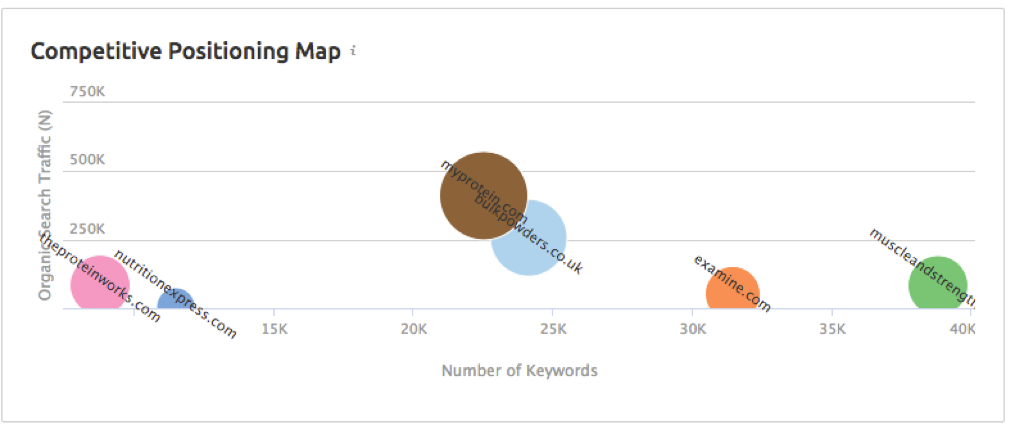
MyProtein has been used in this example. Here, we can see that they are performing well for organic traffic but could be ranking for more keywords. From the above graph, it is clear that three organic competitors have a higher number of keywords, which could be undiscovered opportunities.
Using the same process plug your domain into the Ahrefs dashboard and on the left navigate to “Competing Domains”. This will give you a list of domains based on their unique and common keywords.
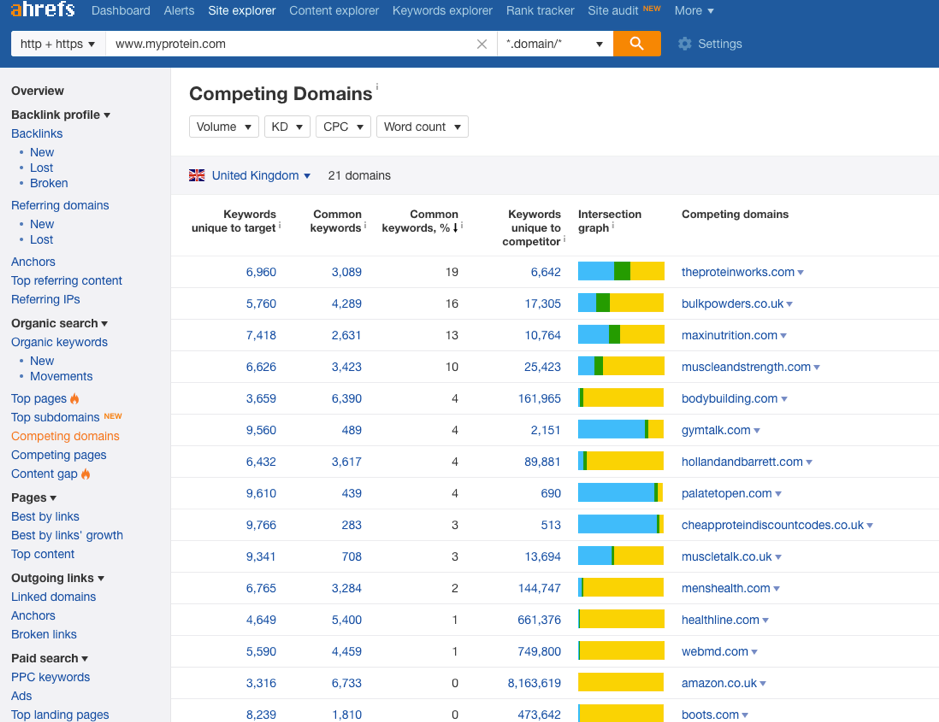
Main organic competitors will be listed at the top. It is these competitors that need investigating when starting your keyword gap analysis.
2. Find the keyword gap
Using the same two tools we can discover the keyword opportunities.
SEMRush provides users with the “Keyword Gap” tool, which allows you to toggle between a table and chart view.


With this you navigate through volume, keyword difficulty and discover which out of the competitors analysed are in top position for a certain keyword.

The filter option gives one the ability to choose between different options such as 'unique', 'common' or 'unique to the first domain's keywords'.
Using the Content Gap tool by Ahrefs, take the three domains identified above with heavier keyword volume and place them into the tool.
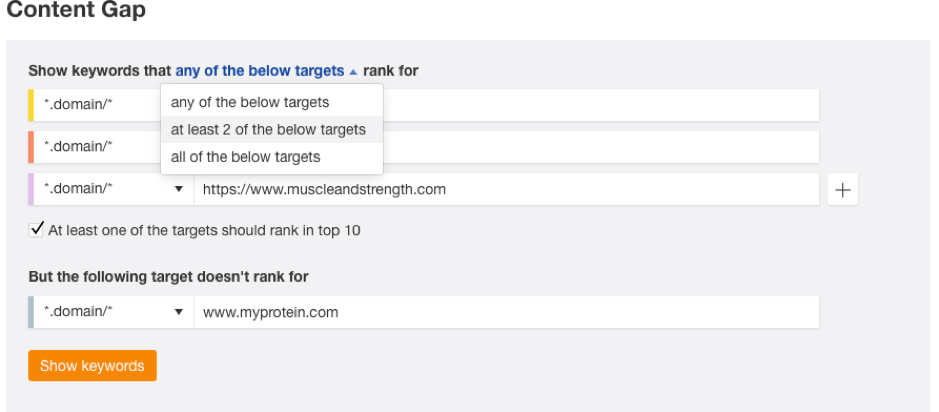
Once you have run this report, you will get a table with the results, this splits down the competitor, the specific keyword and the current position that the competing domain holds. There are also other filters that will help with your analysis such as filtering by just one, or all, of the targeted competitors - as well as the ability to add a range of other competitors to the initial evaluation.
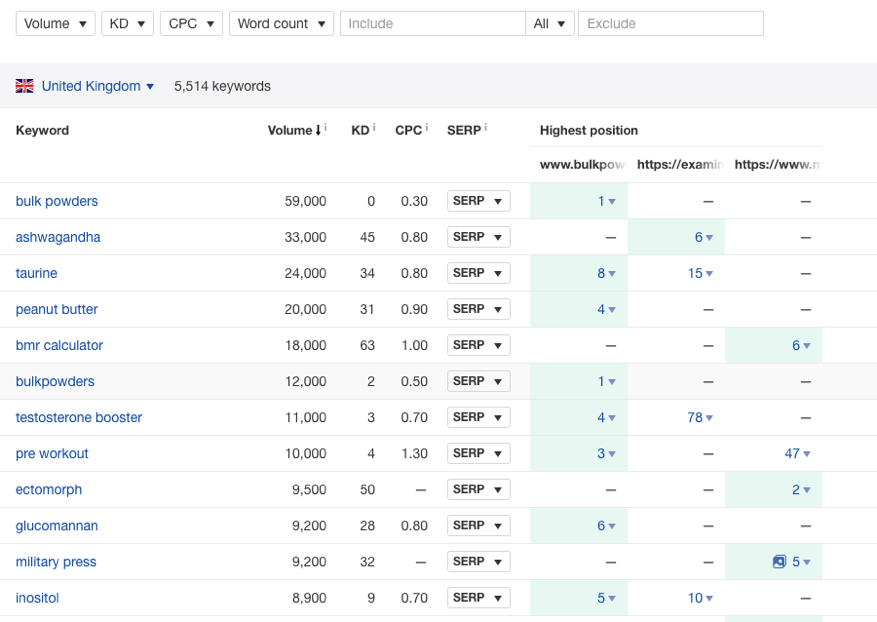
There are 4,591 keywords that have been identified which could potentially be a great opportunity for MyProtein. This helps build keyword research, market analysis and strategy reports to give a further understanding of which angle any company could take to boost traffic and conversions.
Comparing a page, article or campaign
Let’s say, you might want to compare a single page or an article against your competitors to evaluate performance. Both Ahref and SEMRush allow you to compare against page, not just domain.

In this example we are comparing a range of competitor articles to gather further insight.
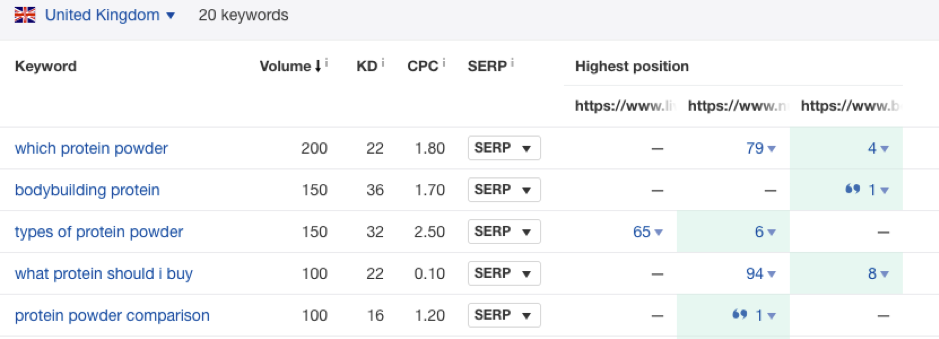
This is a useful method to enhance existing page performance and bring new traffic to any site.
3. Export your report
Export your report and open it in Excel, whichever tool you have used, a similar format will be displayed, these will include the primary metrics:
- Keyword
- Search volume
- Keyword difficulty
- The ranking position of competitor chosen
So, what do you do with this data?
Commercial opportunities
Not only will this type of analysis identify which keywords your competitors rank for that you don’t, but it can also prove to be extremely useful when considering product and commercial business decisions. If a product keyword has a high volume, then it’s obvious that your audience who are searching for this product, are interested in detail with potential purchase intent.
Informational opportunities
Most websites have an information hub, which could be a treasure chest full of informational keywords (searchers requiring information which your content should answer). Using the prefix option in the gap analysis tools you can find informational gaps, for example look at subdirectories like /blog/.
This type of informational research can be a forefront in the consideration of creating content pieces around a subject, increasing brand reputation and potential conversions - this can even be crucial for voice search if your business has an opportunity to capitalise on voice queries. You can read more about how to create a voice search marketing plan in our playbook.

Evaluate the competitors
Look at each competitor and filter to find which keywords they are in top positions for. This will identify their strongest pages and content. Let’s take “pyramid training” for example, Bulk Powders rank top position for this.
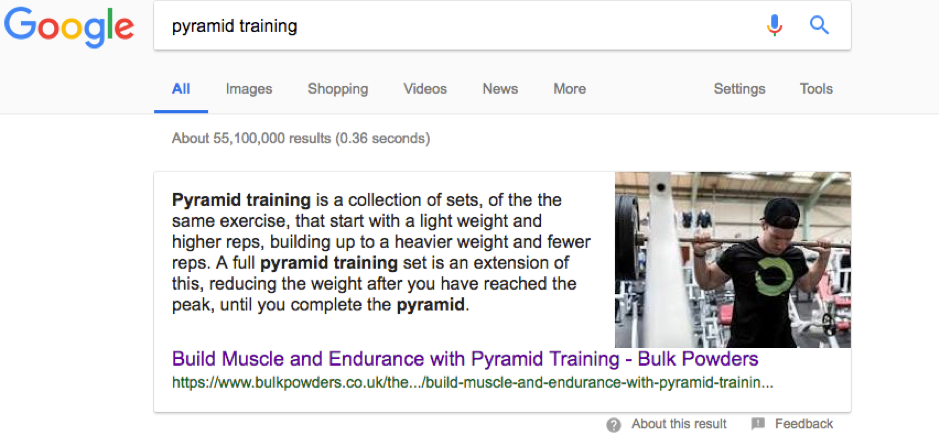
We can see in the example that the featured snippet and top position ranking have been achieved. In this instance evaluating the featured snippet data, referring domains and content evaluation will give a clear indicator of the possibility of ranking for this.
Keyword difficulty
If you want potential quick wins then filtering by keyword difficulty highlighting low competition level will provide direction. We have our own free downloadable tool to support on this, and a post over on Search Engine Watch to explain how to use it.
Filter the exported spreadsheet, discover the keywords with a high search volume with a low keyword difficulty, consider pages within your own website that could rank for this keyword, or look at creating a page around this topic.
Discover featured snippet keywords
Achieving featured snippets is another method of gaining more clicks without ranking in the first position. A study was done by Ahrefs to show when a featured snippet is present for a keyword that the page below it (1st position) loses 8.6% of clicks on average to “position 0”. That is why these are a great way to steal clicks from competitors and raise brand awareness.
So, with the gathered keyword data from your gap analysis, how do we find out which keyword is ranking for a featured snippet?
Again, we can use a number of tools, but in this example Ahrefs Keyword Explorer tool has been used. Plug a range of your keywords from your report into the tool.
Automatically these keywords will be separated with a comma, running this will take a few minutes to gather the data.
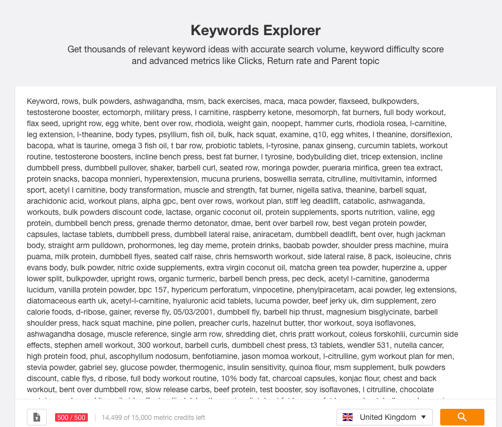
This dashboard will appear.
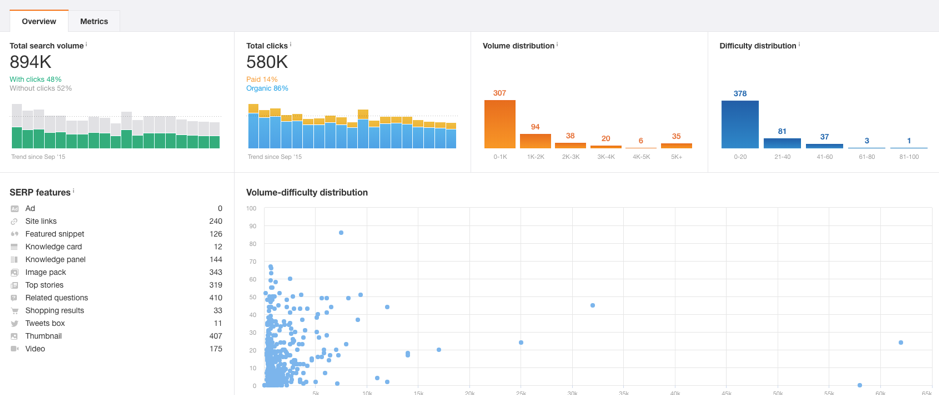
We can see that SERP features have been indicated in the report.

Ahrefs highlights a number of SERP attributes that are related to that keyword.

Export the keyword report and navigate to the SERP features column, and you will get a range of data based on what features are related to that keyword. Filter the report to include “featured snippet”, these are now the keywords from your gap analysis that contain a featured snippet.
Evaluate the snippet and the page that is currently presented, identify the type of snippet that is being displayed and structure your page accordingly to help achieve these results.
For more on how to rank for featured snippets please see Zazzle Media’s featured snippet guide.
Branded Keywords
Branded terms tend to have quite a weighted keyword volume if brand protection isn’t one of your competitors main focuses, then trying to gain first-page ranking for their terms could be a strategic win.
Example, “muscle and strength” aren’t protecting their branded keyword as it is an industry generic term, there is a first-page opportunity here that could provide organic benefits to MyProtein.
How conditional formatting can identify competitors unique keywords
If you are looking at comparing a large range of competitors and want to find their own unique keywords, then conditional formatting within Excel can be a great tool to do this across a range of online market leaders.
Export all competitors keyword sets from either Ahrefs or SEMRush and place them in an excel spreadsheet column, along with your original keyword set (either yours or your clients ranking keyword set).

In 'Conditional Formatting', navigate to 'Highlight Cell Rules', 'Duplicated Values' and then format only the duplicated values. This will highlight all values that are duplicated, any that aren’t highlighted are unique values to that website.

Then filter the cells that haven’t got a colour assigned, giving you a unique value. Many results gained from this will be branded terms, however, non-branded terms will provide a greater understanding into what products your competitors might be selling that the other online industry leaders aren’t, as well as informational topics and questions that could pose useful content to your audience.
This same method works well when comparing against just one competitor and will give specify a larger keyword set that could provide further value.
When should you perform keyword gap analysis?
This method can take place in any stage of strategy building, competitor performance, quick win analysis and potentially revenue building. Starting gap analysis early will help any SEO get more of an idea of the market and their main competitors helping to build a forward-thinking strategy.
Sign up for our monthly newsletter and follow us on social media for the latest news.





 Proudly part of IPG Mediabrands
Proudly part of IPG Mediabrands